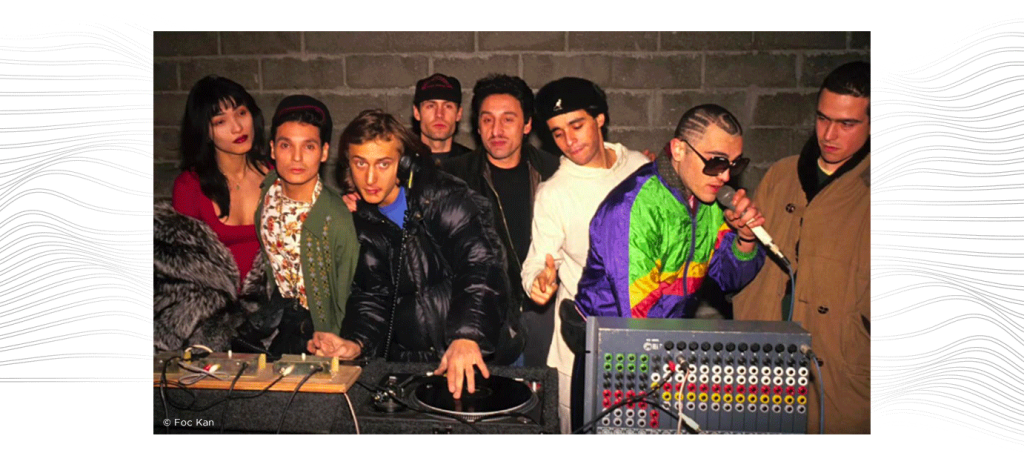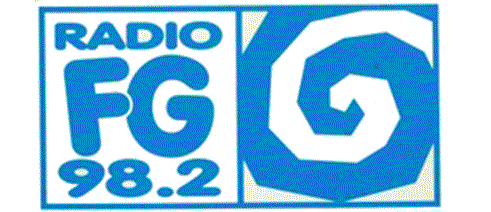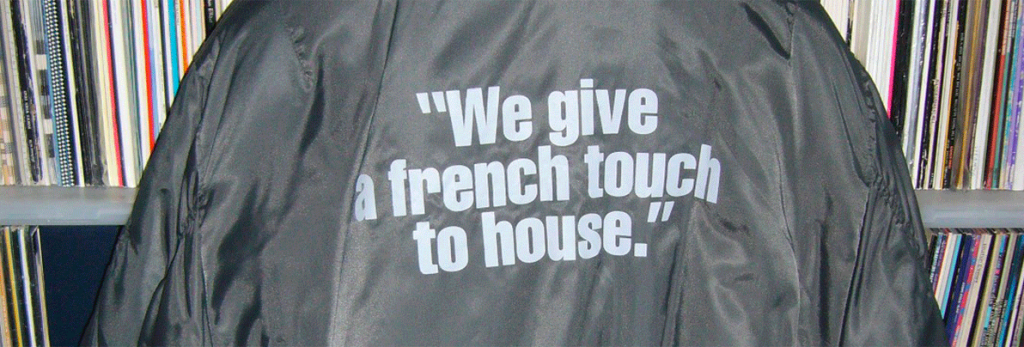

An unusual underground rave was held in a highway tunnel that was still under construction beneath the business district of La Défense. Pat Cash, a major figure in Paris’ underground scene in the 1980s, organized the event. The rave featured an eclectic mix of music from a range of DJs, including David Guetta, Ariel Wizman, and Albert de Paname, who was known at the time for his sun-drenched sets at the Balajo. In 2016, the documentary Ex-Taz, directed by Xanaé Bove, told the story of this unusual figure, who became a rabbi in Israel.

From left to right: Lychee, Jean-Claude Lagrèze, David Guetta, Albert de Paname, Ariel Wizman, and Pat Cash under the La Défense tunnel
Luc Bertagnol, a former partner of Rave Age and a co-organizer of the label’s parties along with Manu Casana, founded his own organization called Cosmos Fact and moved to the top floor of a factory in Montreuil called Mozinor. A series of legendary parties took place there once a month between April and December 1991. Luc Bertagnol subsequently moved on, but the site continued to be used for the next few years.

Flyer from the Raveolution party

Flyer from a Tekno Tanz party
The first Tekno Tanz party was held in the Cergy-Pontoise recreational area. DJs Laurent Hô and Liza N’Eliaz delivered a harder-sounding techno than what was typically played at a traditional rave. The event’s organizer, Fabrice Rackam, later turned to trance music, hosting large annual Gaïa parties. Twenty-five years later, his organization remains active, a rarity in the field.
In mid-1991, a new station joined Paris’ FM airways that would go on to play a pivotal role in popularizing electronic music. In point of fact, Radio FG had existed since France ended its public radio monopoly in 1981. Originally geared towards the gay community, it operated under the names Fréquence Gaie, Future Génération, and finally Filles & Garçons. However, the radio often found itself on the brink of shutting down due to infighting and political rivalries. In 1990, the heavily indebted Radio FG even shut down for a few months before being reopened as a community station by its president, Henri Maurel. Under his direction and that of program manager Patrick Rognant, the station pivoted yet again, deciding to only play electronic music. It also adopted a provocative slogan, “La radio des scotchés,” which loosely translated means “the radio for addicts”. Numerous DJs active in the French scene were asked to give live performances. The station’s studios became a central meeting place for those involved in the techno and house scene. Every Saturday night, Patrick Rognant’s “Rave Up” show was required listening for anyone who wanted to hear about upcoming parties and how to find them.

During the week, “Happy Hour” focused on club events in Paris. Later, the journalist Jean-Yves Leloup launched “Global Tekno,” a multi-disciplinary magazine that looked at culture through the lens of techno music. Every day at noon, “A Deep Groove” featured the deep house stylings of DJ Deep, Grégory, Erik Rug, and Alex From Tokyo. The quality of Radio FG’s programing made it truly one of a kind. Between 1996 and 1998, the station gradually lost its association with the gay community and took full advantage of the “French Touch” trend. In 2001, Radio FG finally received permission from the CSA, France’s regulatory body for audiovisual media, to become a national network. Under the direction of its new manager, Antoine Baduel, the station started catering to a general audience and adopted a more commercial approach. Underground artists and productions were no longer a part of the line-up.

Fnac Music Dance Division promotional jacket
While the party scene was in full swing and the number of DJs was increasing, almost all the records played during raves and club parties came from abroad. Except for Manu Casana’s under-the-radar Rave Age, there were very few producers in France and even fewer record labels. Enter Eric Morand. The young product manager from Barclay music company was passionate about this new sound and later joined Fnac with lofty ambitions. Fnac was one of France’s largest music retailers at the time and was looking to start its own record company. Eric Morand founded the dance music division of Fnac Music. He received substantial funding and, importantly, was given free rein to select artists.
The organization carried out the distribution of international electronic labels such as Warp, Plus 8, Strictly Rhythm, and Djax Up Beats. Its catalogue even included hip-hop productions under the American label Tommy Boy. However, Eric Morand wanted to promote the spread and production of a real French electro scene. The first artist the company signed was none other than Laurent
Garnier, who released a maxi single entitled “As French Connection.” Other artists followed, including Scan X, Shazz, and Deepside (also known as St Germain). Initially, since sales remained low, the label adopted the look of a traditional record company, publishing artist photos and biographies along with meticulously designed album covers.
Techno aficionados spurned the move, finding it too commercial. In 1993, Fnac Music finally made it big with the hits “Wake Up” by Laurent Garnier and “The Meltdown” by Lunatic Asylum. The international press finally took notice of the French scene, and records started to be sold abroad. In celebration, the label made a jacket printed with the prophetic phrase, “We give a French touch to house.” Despite its late-blooming success, the directors at Fnac lost faith in the label’s future. A retrospective compilation called “La Collection” was released as a sort of tribute in February 1994. Eric Morand and Laurent Garnier left to found the independent label F Communications.